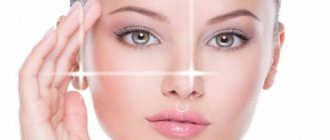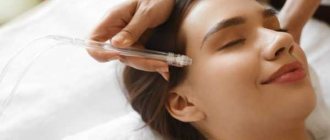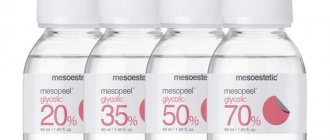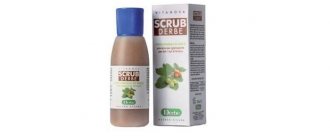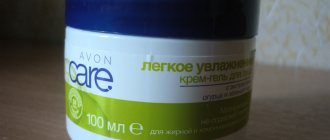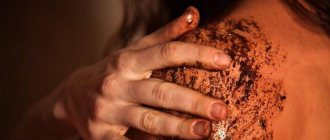The main differences between the components of a scrub and peeling
Be careful! Before using a cleansing cosmetic product, you need to find out how a scrub differs from a facial peel.
Read the popular article in the category: Gel nail extensions at home for beginners step by step.
Experts warn: their incorrect use, instead of the expected benefit, can give the opposite result, causing harm to the skin.
We will tell you in our article what is the difference between a scrub and a facial peeling.
Before choosing such a product, you need to become more familiar with the methods of skin cleansing, find out how they differ and what results to expect. It is important to know the contraindications for each cosmetic procedure.
What is the difference between a scrub and a facial peel, because the results of their action are very similar.
To find out this, you need to understand what components are included in their composition and how they affect the epidermis.
Composition of peeling and scrub for cleansing the skin
| Cosmetics | Compound |
| Scrub | Viscous base and fine solid particles |
| Peeling | Acid base and very fine abrasive particles |
The basis for the scrub is cream, gel or clay. It contains solid particles. For this, crushed apricot and grape seeds, crushed nut shells, wax granules or salt are used.
You should know! The solid particles of scrubs are not always smooth, sometimes they cause microtraumas, and this is not desirable especially for skin prone to redness, that is, to dilation of blood vessels with the appearance of bluish-red formations, star-shaped spots with many branches.
This is what a facial scrub consists of; it remains to be seen how peeling differs from it. The basis of a standard peeling consists of very small solid particles, cream or gel, but this mass has a more liquid, watery consistency, reminiscent of milk.
Defining concepts
The main difference between a scrub and a peel is what each of them is. A scrub is a product that exfoliates and smoothes the skin, removing dead cells. The result of scrubbing is smooth and delicate skin, cleansed pores, and a fresher complexion.
A scrubbing agent is solid particles of artificial or natural origin (for example, ground coffee or nut shells, mineral granules, salt, sugar, etc.) on a cream or gel base. When it comes into contact with the skin, the scrub seems to polish it. The product can be easily prepared at home.
Peeling is a product that affects the epidermis, penetrating the pores and dissolving dirt, dead cells and everything that accumulates on its surface. In addition, this procedure allows you to:
- rejuvenate the skin;
- eliminate pigmentation (post-acne spots, freckles, etc.);
- smooth out scars and other defects;
- improve turgor, reduce wrinkles.
Peeling has a deeper and at the same time gentle effect and can solve a larger number of problems.
It is better to entrust the procedure to a cosmetologist in the salon, especially for deeper effects. But superficial peeling can be done at home using, for example, citrus juice, berries, fruits, but only if there is no allergic reaction. This home remedy will cleanse pores, restore a healthy and fresh complexion, and reduce inflammation.
Differences in the mechanism of action of scrub and peeling on the skin
Peeling is a deep cleansing of the skin . To achieve such goals, it is based on different acids: salicylic, azelaic, retinoic, glycolic, trichloroacetic, ascorbic (vitamin C) and fruit.
Read the popular article on the site: Comfortable long-term hair removal: Sugaring at home. How to prepare the paste and do sugar hair removal correctly.
For more gentle facial care, peeling creams are produced. To give them a softening effect, oils, plant extracts, amino acids, vitamins, elastin and collagen are added to the base.
Cream peeling, having a double effect, exfoliates dead skin cells well, cleanses pores, eliminates acne, makes the skin soft, tender, elastic, moisturized, while simultaneously nourishing and rejuvenating it. Thanks to this, shallow wrinkles and skin unevenness are smoothed out.
Note! All cosmetics are selected according to skin type.
Peeling differs from scrub in the composition of the components and their effect.
When buying a cleansing cream, cosmetologists recommend taking into account that the main function of the scrub is to remove dead skin cells from the upper layer of the skin and eliminate roughness.
It will also perfectly cleanse the pores, giving them access to oxygen. Regular use of the scrub will make your skin beautiful, soft and healthy. Thanks to this, it will have a pleasant natural color and become well-groomed.
Peelings are cosmetic products for deeper cleaning ; they differ in the way they penetrate deep into the skin, so they come in superficial, medium and deep action.
The use of special creams makes the peeling softer and more gentle, and the composition of the scrub is harsher, the effect is mechanical.
Peeling is based on very small solid abrasive particles, so its effect is much gentler than that of a scrub. It injures the skin less, but also has a weaker massage effect.
How do acids that are part of peelings work?
| Acid name | Action |
| Salicylic | Well relieves skin inflammation, helps fight acne |
| Azelaic | Suitable for skin with rosacea, has a whitening effect |
| Fruit (milk, glycolic, lemon and others) | Moisturizes, stimulates collagen production, relieves inflammation |
| Retinoic and glycolic | Cleanses and renews skin |
At home, use only those peels and scrubs that are sold in stores. They are usually intended for superficial and medium cleansing, and are based on fruit acids. These are the simplest and safest means; if you need a stronger effect, you will have to go to a beauty salon.
What exactly is the difference between a scrub and a facial peel ; another question arises: is it possible to combine them, as well as how to do this correctly.
Exfoliating peeling treatment
The word “peeling” is translated from English as “peeling” or “peeling”. Depending on the method of exposure to the skin, it can be mechanical, chemical, physical, laser and enzymatic.
During mechanical exfoliation, layers are removed from the surface of the skin. Peeling is carried out using a grinding machine and attachments with abrasive particles. The procedure is reminiscent of surface treatment with sandpaper. The stratum corneum is also removed with a stream of abrasive particles released under pressure along with air or water. The face is cleaned with a vacuum and polished with ultrasonic waves. An exotic type of mechanical facial peeling - with the help of garra rufa fish. Diamond facial peeling is also gaining popularity, read about what it is.
Video of the exfoliating peeling procedure:
Chemical peeling is carried out using various acids that cause burns to the skin. The burned epidermis begins to actively recover, producing a large number of new corneocytes. The severity of the burn and the depth of cleaning depends on the concentration of the chemical and the time of exposure. A good acid peel can not only improve complexion and normalize the desquamation process, but also reduce the depth of wrinkles. For example, peeling with glycolic acid.
Deep chemical peeling is often used to improve the skin health of older women. Here are all types of chemical peeling for the face. At home, you can exfoliate your face with calcium chloride.
Methods of physical cleansing of the skin include brossage and cryopilling. Brossage is a method of removing dead skin particles using a rotating brush made of natural bristles. For the cryopilling procedure, liquid nitrogen is used, the boiling point of which is -195.8ºС. Extremely low temperatures cause sudden freezing of intracellular fluid and destruction of intercellular connections. The upper layers of the stratum corneum are exfoliated, and the lower ones are activated. Cryopilling causes noticeable rejuvenation of the skin.
Laser peeling is carried out using a beam of directed electromagnetic waves of a certain spectrum. The laser removes dead cells and stimulates tissue regeneration. Laser peeling can be superficial and deep.
Enzymes are used for enzymatic peeling. These substances break down keratin and loosen the cohesion of corneocytes, allowing them to slough off easily. Enzymatic peeling affects only the upper stratum corneum of the epidermis. Also read what gas-liquid facial peeling is.
Is it possible to combine a scrub with facial peeling?
Peeling is a less traumatic procedure, but this does not mean that it can be used more often. If the skin tolerates it well and requires deeper cleansing, then ideally, sometimes, scrub and peeling are combined.
When using them together, the procedures are done one at a time, starting with a scrub. To do this, wash your face with baby soap, then apply the product without touching the eye area. Using light circular movements of the fingers, massage the face for 2-5 minutes, gently rubbing the cream into the skin.
Particular attention is paid to the nose and the entire T-zone of the face . It is often oily, and pores become clogged and can form acne. Cosmetologists recommend steaming the skin before mechanical facial cleansing. It will warm up, the pores will open, this will allow the scrub to act more effectively.
After it has been wiped off with a napkin, peeling is applied and left for several minutes; it will complement the cleansing process; now the skin will be much better able to get rid of old dead cells. Without the preliminary use of a scrub, peeling would not be able to remove the mass of cells that can be removed through joint efforts. Therefore, they purchase both products, which they simply cannot do without.
Important to remember! Not only how these tools differ, but also how to use them. After use, the facial scrub can be wiped off with a napkin; peeling is removed by thoroughly rinsing it with water; residues can cause irritation.
Important to remember! The scrub is used 2 times a week, peeling only 1 time.
Peeling roll or scrub: tips for choosing
The peeling roll acts more gently and does not injure the skin, so it is suitable even for women with sensitive skin. Girls with normal to oily skin can use both products. However, when buying a scrub, cosmetologists advise carefully studying the label and checking which scrubbing particles are used in it: granules that are too coarse can harm even the densest skin.
Since the peeling roll is a fairly non-aggressive product, it can also be recommended to women who often resort to deep cleansing of the skin. Those with normal skin can use it three times a week, and those with dry skin can use it once every 6-7 days. It is very important not to abuse this product and remember that the peeling roll is not an alternative to a gel for washing and it is strictly not recommended to use it every day.
When choosing a peeling ray, pay attention to what active substances are used in it. Traditionally, these are fruit acids: malic, grape, pineapple, etc. If you have problem skin and often have comedones and inflammation, you can choose a salicylic acid-based product.
When and who should not cleanse their face with scrub and peeling?
If the skin is too sensitive and prone to allergic reactions, such cleansing procedures cannot be used. Experts advise finding out which components you are allergic to, and only then selecting the appropriate remedy.
Cleansers are not applied to the skin around the eyes, nor are they used for diseased skin; first you need to cure it, only then apply a scrub or peeling. They are not used for herpes and during illnesses, such as colds, or for people with cardiovascular insufficiency. If your liver or kidneys are sick, do not do deep peeling.
For people with thin and sensitive skin prone to rosacea, regular scrubs are contraindicated. Instead, it is better to choose a more gentle peeling cream that includes softening and nourishing agents and moisturizing additives.
Before using these products, you must carefully read the instructions for use, and also review its composition to determine whether it contains components that are not suitable for the skin, only then can you use them.
If after the procedure there is irritation, wounds, redness or rash on the skin, contact a dermatologist. These funds can no longer be used.
Let's summarize the prohibitions. Carrying out cosmetic procedures to cleanse and rejuvenate the skin is not recommended for the following conditions:
- pregnancy and lactation;
- the appearance of Herpes or other inflammatory processes on the skin;
- the presence of scratches, wounds, warts, moles;
- the presence of fever and exacerbation of chronic diseases.
Scrubs and peelings...What's the difference? What to choose?
We are lucky - our skin is naturally capable of self-renewal. That is, skin cells work, multiply, divide - in a word, regenerate. The life cycle of facial skin cells is on average about 4 weeks, while the process of aging and renewal is ongoing, dying cells accumulate on the surface of the facial skin, causing various problems from an unhealthy “gray” skin color to peeling and a tendency to acne. Without the help of a scrub, dead cells will not go anywhere unless you help them. They will remain on healthy skin, clog pores and become parasitic. If you wipe them off your face in time using simple manipulations, then the skin remains fresh, the cells are renewed, and the pores are clean. The scrub is designed to carry out deep active cleansing of the skin, its renewal, while it is very important to prevent damage to young cells.
What is the difference between a facial scrub and peeling? What to choose? And how to apply?
First, let's try to figure out what peeling is. The word “peeling” refers to completely different procedures: from simple exfoliation before toning the skin, to serious operations. The word "peeling" comes from the English. Reel (remove a layer from something) means the procedure for removing the superficial dead and keratinized layer of skin, as a result of which wrinkles and unevenness are smoothed out, skin renewal processes are launched, and it becomes more elastic. In modern cosmetology, there are several types of peeling, namely cosmetic, mechanical (microdermabrasion, dermabrasion), physical (ultrasound and laser) and chemical (fruit acids, trichloroacetic and salicylic acid, phenolic acid).
The simplest type of peeling used at home is cosmetic using scrubs and gommages. There is no fundamental difference between them: scrubs contain hard abrasive particles, so they should not be used on sensitive skin; Gommage (from the French gomme - eraser) has a more delicate consistency, and those with thin, delicate skin can use it without fear. Gommage is an exfoliating cream based on various exfoliants - agents that cause accelerated exfoliation of the top layer of skin, but, unlike a scrub, it does not contain mechanical particles. Peeling gels are more of a type of gommage; Due to acids (usually fruit) and other components, peeling gels roll off dead skin cells from the surface of the skin without injuring it, and have a whitening and lifting effect. Often, peeling gels, or as they are also called: “gel-roll or peeling-roll,” are an order of magnitude more expensive than other facial products.
What to choose? There are certain secrets here that are associated exclusively with your skin type.
Scrubs consisting of natural ingredients (such as grape seeds, apricot kernels, walnut shells or almonds) are more traumatic for the skin, so if you have sensitive skin, such scrubs are not suitable for you. I note that in “store-bought” face scrubs, 90% of the scrubbing components are, precisely, natural scrubbing elements. If you have sensitive skin, or (even worse) a tendency to show inflammation on your face, is this not for you? Why? Hard scrubbing particles will injure the skin, causing even more unpleasant phenomena (pimples, inflammation). Who is it suitable for? Ladies with normal skin, “hardy” to such harsh cleaning. Such scrubs perfectly get rid of blackheads and perfectly remove dead cells of even the most old origin.
Scrubs with artificial polymers are suitable for any skin type. It all depends directly on the size of the particles contained in the composition. If the polymers are small and round, they do not injure the skin, but gently cleanse it of dirt, dead cells, fat and sebum. Such scrubs are suitable even for the most sensitive and thin skin. For gel facial scrubs I use either these or jojoba wax. But more on that later. Scrubs with artificial abrasive particles are intended for daily and frequent use. Their effect gradually “accumulates” and after a week or two reaches its maximum effect. The base of these scrubs can be either cream or gel.
If you see tiny wax balls as scrubbing additives in your scrub, your facial scrub has the following properties: it is not for oily skin (because it is not able to deeply cleanse pores); Perfect for ladies over 35 years old, because... has the property of polishing the skin, i.e. will smooth out wrinkles; Suitable for sensitive skin, because... will not provoke new inflammations on the face. Well, massage with wax grains stimulates the skin to renew its cells. That is, using such a scrub, we get: cleansing and massage.
Often scrubs have several additional functions. For example, there are scrubs with a special composition that “steam” the skin before the procedure. Such sauna-effect products are most effective for cleansing the skin of blackheads. The process of use is simple - first you apply the scrub to dry facial skin, avoiding the eye and lip area, wait literally 5 minutes. During this time, the composition warms up the skin cells, thereby opening its pores. Open pores are much easier to clean from excess sebum and impurities that clog them, which appear to us in the form of hated blackheads. Next, you simply mechanically cleanse the skin with massage movements and rinse off the scrub.
Well, peeling gels...
This is an excellent product for sensitive skin, skin with age-related changes, and even oily skin. Yes, this type of scrub really suits everyone without exception. I have already described the effect of peeling gels above, I will not repeat it. I will add the following: peeling gels do not contain scrubbing additives; This is the only type of scrub that truly moisturizes the skin.
In conclusion, I’ll tell you how to use scrubs correctly for the benefit of your skin.
Before peeling, the facial skin should be steamed in a water bath or warmed with a hot towel.
The scrub is applied to clean, damp skin, excluding the skin around the eyes, and massaged into the skin with the pads of your fingers (can be combined with a brush or sponge for scrub). Rinse off with water after 3 minutes.
Apply the gommage or peeling gel with your fingertips onto dry skin and 10-15 minutes after drying, carefully remove it, holding the skin so as not to stretch it, as if rolling the gommage together with the top layer of the epidermis.
After the procedure, the skin must be toned and a cream, or best of all, some kind of mask (moisturizing, nourishing, vitamin) applied to the face, since after peeling the active ingredients will easily reach the deep layers of the skin.
When deciding what to choose for peeling - gommage, scrub or peeling gel - and how often to do it, remember the characteristics of your skin. If you have dry or normal skin, then you should use the scrub no more than once every ten days. If you have oily or combination skin, you can perform a deep cleansing procedure once or twice a week. If your skin is very sensitive to external influences, then it is better to refrain from using a scrub and use a peeling gel.
If you liked my article and have any questions, I will be happy to answer them.
I thank my friend, cosmetologist Nastya Denisova, for her help in this article.
Next time in the master class section I will share recipes for scrubs and peels that any of you can make.
Always be beautiful!
What results should you expect when using facial scrub and peeling?
Scrub – superficial cleansing of the skin. Peeling is more in-depth, focused on its rejuvenation and elimination of age spots, freckles and scars. Fading skin with slow regenerative and metabolic processes needs these procedures.
With age, the skin loses the ability to independently remove excess keratinized scales, which give it a gray, tired appearance. But as soon as you free her from this burden, she begins to breathe oxygen, absorb nutrients, and her appearance becomes much fresher.
For young girls, peelings are a good preventative against fine wrinkles ; they will smooth the surface, cleanse pores, protect against acne, and support dry and problematic skin. In addition to acids, biological stimulants, vitamins, bleaches and moisturizers are added to peelings. These supplements eliminate complications caused by the procedure.
Regular use of peeling will protect the skin from the appearance of premature wrinkles, improve complexion, smooth and increase its turgor, eliminate acne marks and pigmentation. Knowing the difference between a scrub and a facial peel, everyone will be able to independently choose what procedure their skin needs , as well as determine the frequency of its use.
What is the difference between a scrub and a facial peeling, see this video:
Peeling and scrub - the difference will be explained in this video:
What is a scrub
A scrub is a product with a creamy texture with large abrasive particles. Most often they contain apricot kernels, coffee beans, sugar, sea salt, etc. A gel can also be used as a base, but it is usually thick. The use of a scrub helps to achieve rough mechanical removal of dead skin particles; in addition, it is possible to achieve a massage effect and increase blood flow to the treated area.
The disadvantages of scrubs include excessive trauma to the skin.
Peels: pros and cons
Unlike scrubs, peelings are completely harmless products. They do not scratch anything, and deal with dead scales delicately: they weaken intercellular connections and gently exfoliate cells from the surface. The working substances of modern peelings are gentle components that respect the skin and its microbiome.
Enzymes (enzymes) of plant origin are papain from the milky juice of unripe papaya fruits, bromelain from pineapple stems, ficin from the stems and leaves of the fig tree. Enzymes of bacterial origin (subtilazin, travase), which are produced during fermentation of Bacillus Subtilis bacteria, are also used.
Classic peeling agents are ANA and BHA acids. Typically a weak acid solution is used. Soft, with a physiological pH, it stimulates the synthesis of ceramides, maintains the lipid barrier of the skin, and maintains moisture.
Enzymatic and acid peels work in the epidermis - the uppermost layer. But there is no need to go deeper: the main thing is that the skin receives the signal “there is a lack of cells on the surface” in time and starts the process of producing “young animals”.
